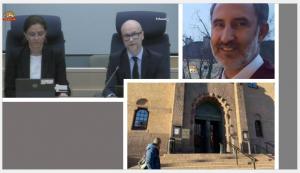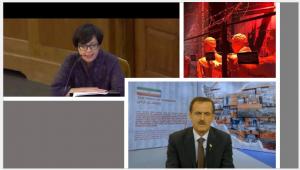(Video) Iran : 34 years later, one of the 1988 massacre perpetrators was brought to justice in a Swedish court.
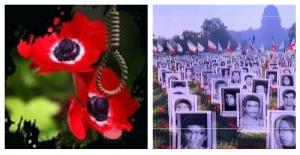
34 years ago, the Iranian regime's supreme leader made the fateful decision to eradicate the Iranian opposition, ordering all political prisoners with ties to the People’s Mojahedin Organization of Iran (PMOI/MEK) to be immediately executed.
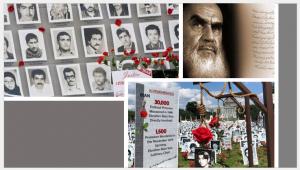
Following Khomeini’s order, on these same hot summer days, in July and August of 1988, every day, thousands of political prisoners were being hanged in prisons across Iran. The 1988 massacre ended with the execution of more than 30,000 political prisoners.
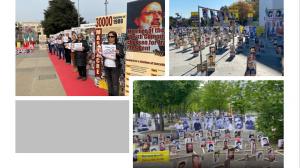
The regime went to extreme measures to hide this heinous crime against humanity, hiding the bodies in unmarked mass graves, keeping families in the dark about the fate of their loved ones, and threatening parents to not hold funerals for their children.
The role of the 1988 massacre in the regime’s politics reached its peak last year when regime supreme leader Ali Khamenei appointed Ebrahim Raisi as president.
Following Khomeini’s order, on these same hot summer days, in July and August of 1988, every day, thousands of political prisoners were being hanged in prisons across Iran. The 1988 massacre ended with the execution of more than 30,000 political prisoners, most of whom were members and supporters of the MEK.
The regime went to extreme measures to hide this heinous crime against humanity, hiding the bodies in unmarked mass graves, keeping families in the dark about the fate of their loved ones, threatening parents to not hold funerals for their children, and later destroying any possible evidence about the mass murders.
The 1988 massacre became a turning point for the regime and became a defining factor in the power hierarchy of the regime. In the three decades that have passed, the main actors and orchestrators of the 1988 massacre climbed the ladder of power in Iran, occupying key positions of power.
The role of the 1988 massacre in the regime’s politics reached its peak last year when regime supreme leader Ali Khamenei appointed Ebrahim Raisi as president.
Raisi is notoriously renowned for being a member of the “Death Commission,” a group of regime officials that acted as judges during the 1988 massacre, setting up minutes-long trials for political prisoners and immediately sending them to their death if they refused to disown their support for the MEK.
While the regime thought that it had managed to root out the MEK and eliminate its main alternative, the Iranian Resistance launched a campaign for seeking justice and truth, immediately warning international bodies and human rights organizations about the tragedy that was going on in Iran.
The silence of the international community and the West’s penchant to turn a blind eye to the regime’s human rights abuses did not deter the Justice Movement in its mission to get to the bottom of the 1988 massacre, to seek truth for the families of the victims and to bring the perpetrators to justice.
MEK activists and supporters inside the country started documenting the 1988 massacre, sometimes at great risk to themselves, gathering every piece of evidence about the victims, the perpetrators, and the locations where the bodies were buried.
The year 2022 marked a turning point for the perpetrators and the victims of the 1988 massacre.
Hamid Noury, a former prison guard in Gohardasht Prison, Karaj, was tried in a Swedish court for his role in the 1988 massacre.
Noury was sentenced to 20 years in prison for his role in torturing and executing political prisoners in 1988.
This was the first time the 1988 massacre was acknowledged and put on trial in a court of law and set a precedent for other countries across the globe to arrest the perpetrators of the 1988 massacre and put them on trial.
And there is no shortage of regime officials whose direct role in the massacre has been documented.
Aside from Raisi and Khamenei, the list includes former justice minister Mostafa Pourmohammadi, head of judiciary Gholam-Hossein Mohseni Ejei, former intelligence minister Ali Fallahian, and dozens of others.
Crimes against humanity are not erased with time. Today, the international community has a role to play in resolving the 1988 massacre of political prisoners in Iran. There needs to be a change in the policy toward Iran’s regime.
After the verdict of the Swedish court, there is no justification to meet and shake the hands of murderers like Raisi. They must be tried and brought to justice for their crimes.
As it has proven in the past three decades, the Justice Movement will not relent in its goal. The world should stand with the victims and families of the 1988 massacre.
Shahin Gobadi
NCRI
+33 6 61 65 32 31
email us here
The year 2022 marked a turning point for the perpetrators and the victims of the 1988 massacre.
Legal Disclaimer:
EIN Presswire provides this news content "as is" without warranty of any kind. We do not accept any responsibility or liability for the accuracy, content, images, videos, licenses, completeness, legality, or reliability of the information contained in this article. If you have any complaints or copyright issues related to this article, kindly contact the author above.

